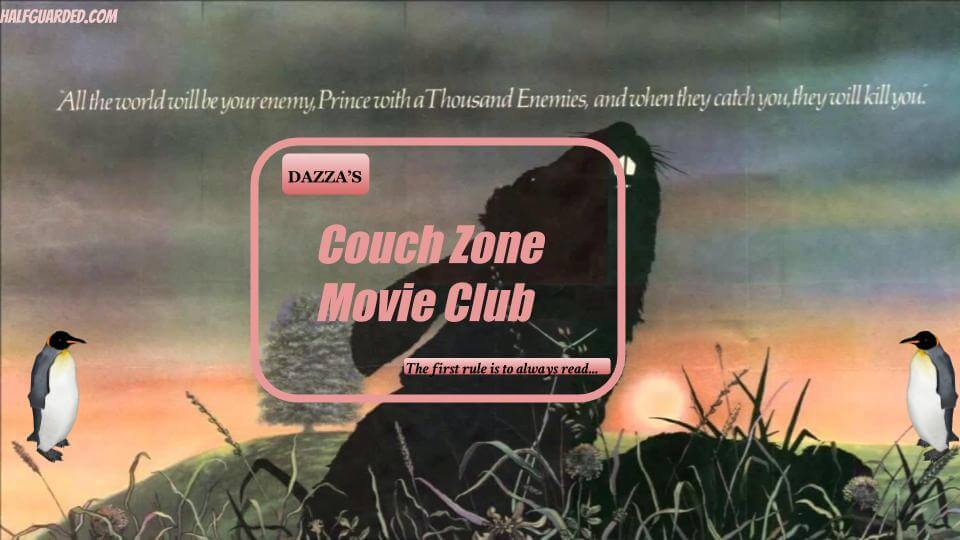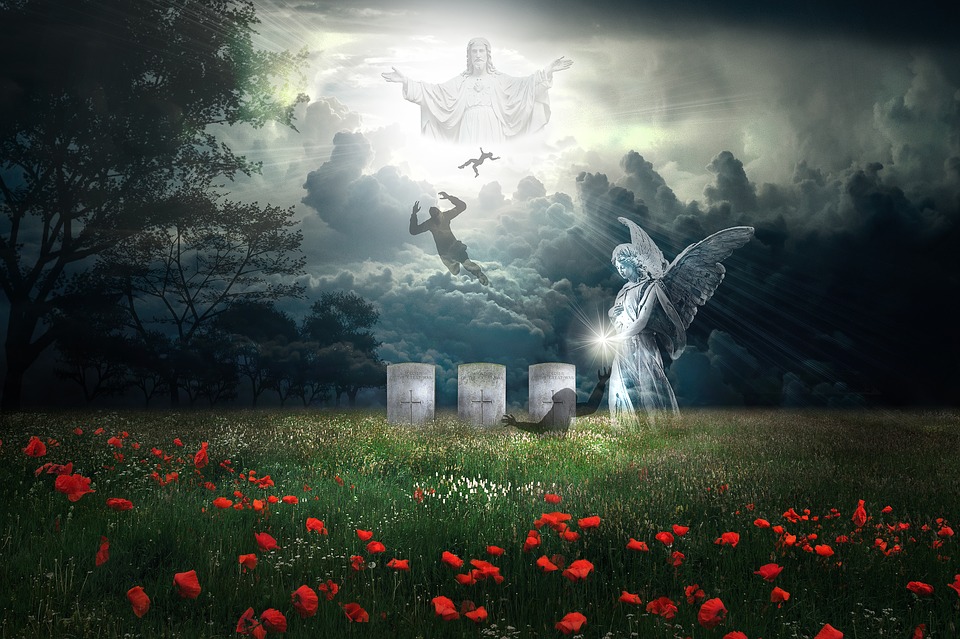1978. A year where we believed a man could fly, that it still wasn’t safe to go back into the water and begged John Travolta and Oliva Newton John to tell us more (like why were they still hanging around in high school at that age).
But I’m not talking about those movies. Instead I’ve found three other films I’ve loved for various reasons and another that is complete drivel.
Watership Down
When it comes to being a dog person or a cat person, I’m really neither. If anything I’ve always been a rabbit person. Probably because I’m sympathetic for their underdogs of life status, but also because rabbits are generally peaceful, harmless creatures and cause little trouble. They also live my dream lifestyle, eating, shagging and hopping around being cute, they’re the hippies of the animal world. Sadly just like hippies this seems to piss other animals off and as a result the drawback of being a rabbit is every other animal claws or human with a gun wants to kill and eat you.
What this is leading to is when I was about six years old I became aware of an animated movie coming out all about rabbits. I was stoked, expecting a fun exciting tale of rabbit adventuring. Digging burrows, hunting for carrots, cute stuff like that. Sure they’d be enemies to face, dogs to outrun, farmers to outwit. But it’s a cartoon about rabbits, it’s gonna be lovely right? You know just like those Disney movies (we’ll forget that Bambi’s mom ends up on the hood of some redneck’s truck cos it kinda spoils my narrative).
Then the theme song “Bright Eyes” was released by Art Garfunkel and that was lovely too. A gentle, whimsical tune that warmed the heart and had a music video that was simply rabbits hopping and lazing around in a beautiful, idyllic countryside. It went to number on the UK singles chart for about seven years it seemed at the time.
There was no doubt that this film was going to be bunnitastic adventure, endearing and charming and fun for all the family.
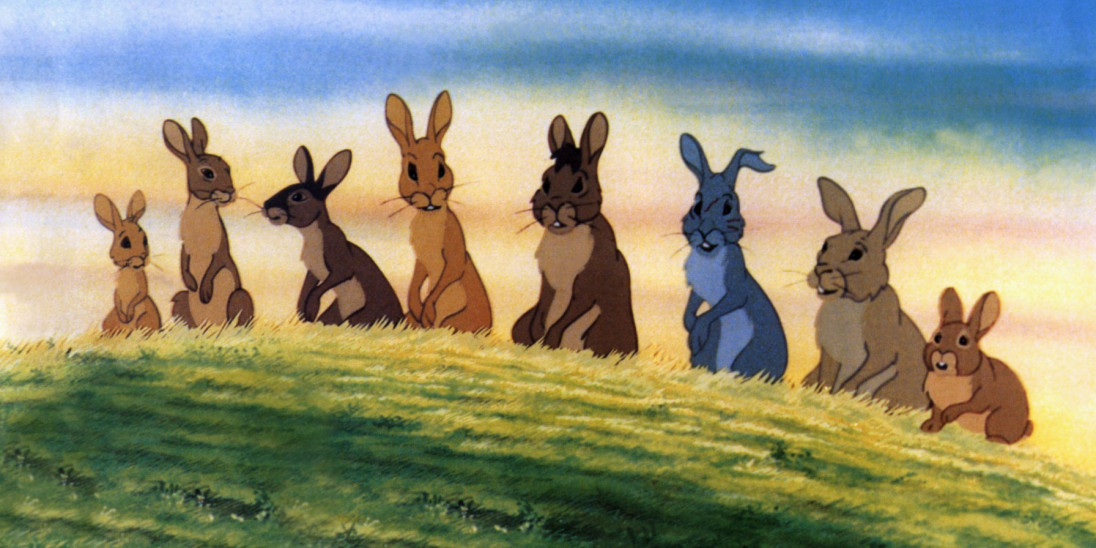
Like Bollocks it was!!! What actually arrived on our screens in 1978 was the Wild Bunch of the animated world. And it was pretty goddamn awesome because of it.
Watership Down is indeed a heartwarming adventure of a group of courageous rabbits who flee their warren in search of a peaceful life, when one of them (Fiver) begins to get visions of a cataclysmic event that will destroy them all (a sign reveals to the audience that the whole every is to be demolished). It’s also at times violently bloody and disturbingly vicious.
Danger follows the rabbits everywhere. They are hounded by the rabbits of their own warren who attempt to stop them from leaving. Seeking sanctuary in a church they are forced to battle a gang of mice. There’s an unsettling scene while encountering a warren of creepy and suspiciously evasive rabbits. It turns out the warren is surrounded by snares that the rabbits accept in exchange for the food the farmer provides to keep a supply of fresh rabbits. A tense scene erupts when one of our main rabbits Bigwig is caught and almost chokes to death on a snare, it’s a distressing moment as he writhes, gasping with blood dripping from his mouth.
An attempt to free some female rabbits from the hutches of a farm brings them into conflict with a dog, cat and the gun of a farmer, leaving the band’s leader Hazel severely wounded. There’s a chilling moment where a survivor from their old warren Captain Holly recounts their destruction with surreal visuals of rabbits crushed and gassed and the land ripped apart by the monstrous metal machines of man.

But the biggest threat to the rabbits comes from their own species, with the discovery of a rival warren. A brutal dictatorship, where rabbits are oppressed by a vicious regime led by the ultimate nightmare of the evil General Woundwort. It’s hard to imagine a rabbit being terrifying, but Woundwort is a living nightmare and scared the hell out of me as a little kid. I had luscious book of the film, which told the story through stills from Watership Down and there were times I could not look at the pictures of Woundwort for long, so repulsively evil did he look, with his blind eye and perpetual snarling visage.
Under Woundwort’s command rabbits who don’t fall into line are clawed to pieces, ears ripped and torn apart and several times we see rabbits savagely bitten to death. There are brutal battle scenes, especially in the final war between the two warrens with a vicious back and forth battle in the cramped burrows between Woundwort and Bigwig. While above ground the rabbits lead by Hazel lure the farm dog into the fray to slaughter the invading forces. In his final scene Woundwort defiant and fearless as ever screams that Dogs aren’t dangerous and launches himself with a roar at the hound. Rather spookily the splendid narration by Michael Hordern (who is also the voice of Frith the God like figure for the rabbits mythology) states that Woundwort’s body is never found and rumour has it he survived the battle with the dog and that for generations to come mothers would warn their baby rabbits that if they did not behave the General would get them).
Amazingly, Watership Down was awarded a “U” certificate by British censors which no doubt left parents horrified as they ushered the more sensitive children out of theatres in tears, although I’m sure were quite pleased as maybe little Lucy was now so traumatised she’d stop going on about wanting a sodding pet rabbit. While even today the film proves a shock to sensibilities (and let’s face it today I think audiences can be more sensitive and fragile), as just a few years ago Channel Five had to apologise for airing the film in the daytime on Easter Sunday, with parents claiming their kids were upset by the violence and that such violence were not suitable for such a Holy day. You know Easter, where a guy who said we should be nice to each other was nailed up and left to starve to death.
I find Watership Down refreshing. Unlike a lot of “family” animated films it has an edge that doesn’t patronise or sugarcoat it’s audience. It’s all about fighting for freedoms in the face of tyranny, the oppression of hierarchies and the danger and violence that you face in taking such a stand. Although modern eyes may baulk at the Rabbits motivations to rescue Does from the other warren and the farm specifically in order to breed with them. However while their is a predominance of male characters, one of the most brave of all is the female Hyzenthlay who rebels under Woundwort’s regime, fighting for better conditions and social justice and helping some rabbits to escape from the hell of the warren.
It’s also a beautifully sweet film. The animation has a charming old school feel to it, the scenery and depictions of the countryside are gorgeously painted with watercolours. The voice cast is an impressive collection of British talent from film, stage and Television. John Hurt, Richard Briers, Nigel Hawthorne, Denholm Elliot, Hannah Gordon, Roy Kinnear, Harry Andrews and Michael Hordon who is splendid as the voice of Frith the Rabbit’s deity. I also like how most of the animals are depicted as close to their natural physical appearance as possible instead of the cartoon look favoured by Disney.
Many years later I still love this film. As I do the Richard Adams book it was based on and is one of the few novels I’ve read more than once (the novel expands more on the mythology and legends that shape the Rabbit’s culture). It’s one of the greatest “children’s” movies of all time and a triumph of British cinema. But maybe be careful when watching it with your kids.

Dawn of the Dead
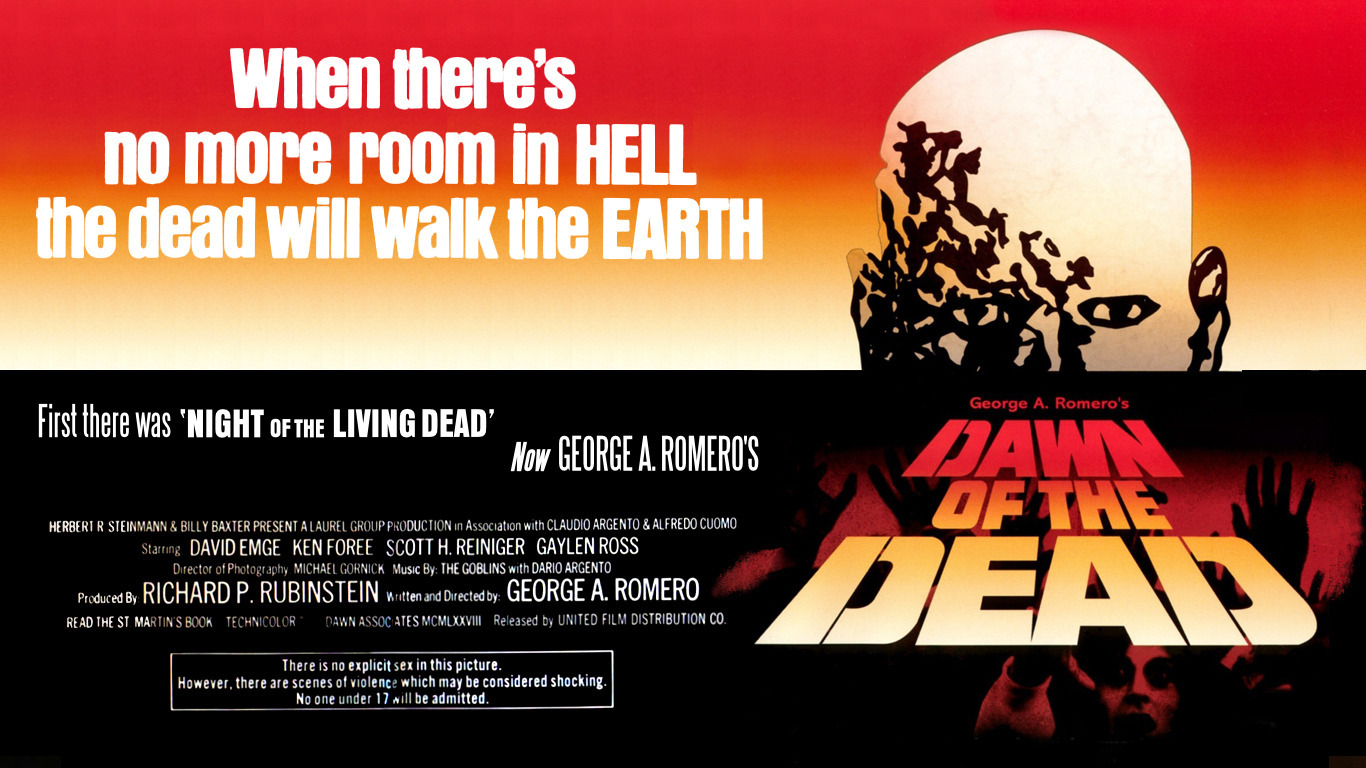
As a kid I usually gave the horror section of the video stores a wide berth, not even looking in it’s direction as I always found the lurid covers unsettling and had little interest in horror beyond monster movies. Occasionally curiosity would get the better of me and I’d sneak away from my parents and have a quick glance at some of the video boxes. One tagline always stuck with me “When there’s no more room in hell, the dead will walk the Earth,” a terrifying slogan that I took literally and imagined the film full of shots of an overcrowded hell refusing anymore souls.
It was some fifteen years later when I finally saw Dawn of the Dead late night on TV and in many ways it was unlike any horror movie I had ever seen. It had taken ten years for there to be a sequel to Romero’s black and white classic Night of the Living Dead. The film shifts focus from the isolated farmhouse setting of “Night” and shows the effects of the epidemic of reanimated corpses on cities and built up urban areas. Within days society is on the brink of breaking down and in the chaos two reporters and two members of a Swat team take refuge in a large shopping mall.
With it’s use of firearms, “Dawn” becomes a hybrid of an action movie and horror. It has a distinctly authentic cheap Grindhouse vibe to it (as opposed to the fake Grindhouse we see today inspired by Tarantinoisms), with plenty of gory, bloody special effects and a blue tinted makeup of the shuffling zombies. I enjoyed the movie on first reviewing but it wasn’t until later that I was through my own experience to appreciate the satire and social commentary Romero added to the movie.

Dawn of the Dead targets the consumer culture that the shopping mall promotes. As someone who worked for many years in a shopping centre like the one depicted I got a real kick out of the way zombies head to the mall, just like they did when they were alive as if one of last vestiges of instinct left in in their ruined minds is the need to visit there. And it translates into how you can look at shoppers in the real world. The way the zombies congregate at the shop windows and paw and groan at the glass resembles the way real life shoppers wait impatiently for closed shops to open their doors. In the closing credits the zombies shuffle without direction through the mall without purpose while bland, hypnotic music plays over the mall speakers and it’s not a million miles away from the reality of shoppers who just wander around from shop to shop without any purpose, doing the same thing weekend after weekend.

In Dawn of the Dead, the undead have been reduced to the very basics of humanity, the need to consume, primarily with human flesh (which in the third film Day of the Dead we find out is futile as the zombies have no way to digest food) but this is naturally a relation to the way as humans they consumed retail goods. This also goes for the surviving humans as well, who having once secured the mall begin indulging in the luxuries that the mall makes available to them. They begin living in a sort of dream world, straight from the catalogues and advertising campaigns that influenced their now defunct society. They began trying on fancy clothes that are no longer practical for survival, taking expensive jewellery to wear (one of them just by instinct checks out the price tags) and even dressing up for a nice sit down meal with cutlery and candles. There predicament allows them to live the ultimate consumer fantasy, but as time goes on it proves empty and unfulfilling as boredom sets in.
Fairing worse as examples of humanity are a raiding motorcycle gang who invade the mall and seem more intent on robbing zombies of their jewellery as they do securing vital supplies. They also amuse themselves with vandalising an electrical store and using the zombies as a form of entertainment, with one of the most surprising moments is a scene with the bikers throwing pies into the faces of the undead. Society has fallen and in Romero’s world certain elements are loving it and having a blast without law and order.
Incidentally this scene looks like the cast are having a blast and much of the film was apparently improvised as the crew had the run of the mall during the night when it was closed.
Dawn of the Dead may put some viewers off with it’s decidedly low budget appearance, but as a survival zombie movie you’ll struggle to find better and is a the highlight in one of the best and most underrated movie trilogies of all time (ok so there were more than three films but you know what I mean).
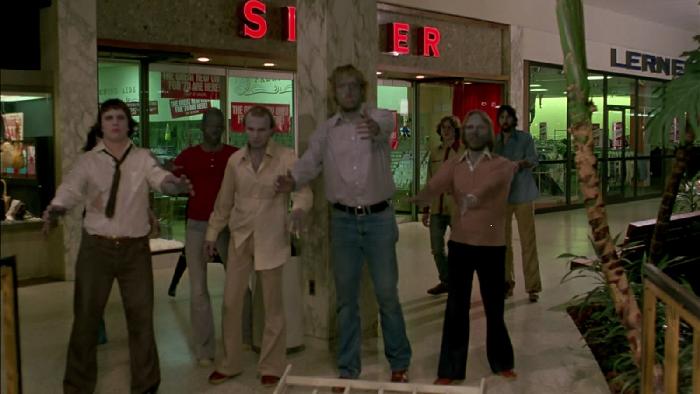
Every Which Way But Loose
.jpg)
Building up a movie collection when I was a kid took some patience. Blank VHS tapes were not exactly cheap (I remember asking for packs of them for my birthday in my early teens) and to record a film off television to keep normally meant to sacrifice another favourite to be recorded over. A couple of Clint Eastwood movies survived a long time, those being Dirty Harry, The Enforcer and rather bizarrely looking back Every Which Way But Lose. Or as as it’s often referred to, the first of those “Fucking awful films with the monkey.”
I loved the movie as a kid and remember watching it many times in the summer holidays. But it is a weird departure for Eastwood, in the years of his grim Dirty Harry and Western personas to do an offbeat comedy where he has an affectionate relationship with an Orangutan called Clyde. Eastwood does more smiling and laughing in this film that in the previous decade of his movies, but that doesn’t mean the film is without action.
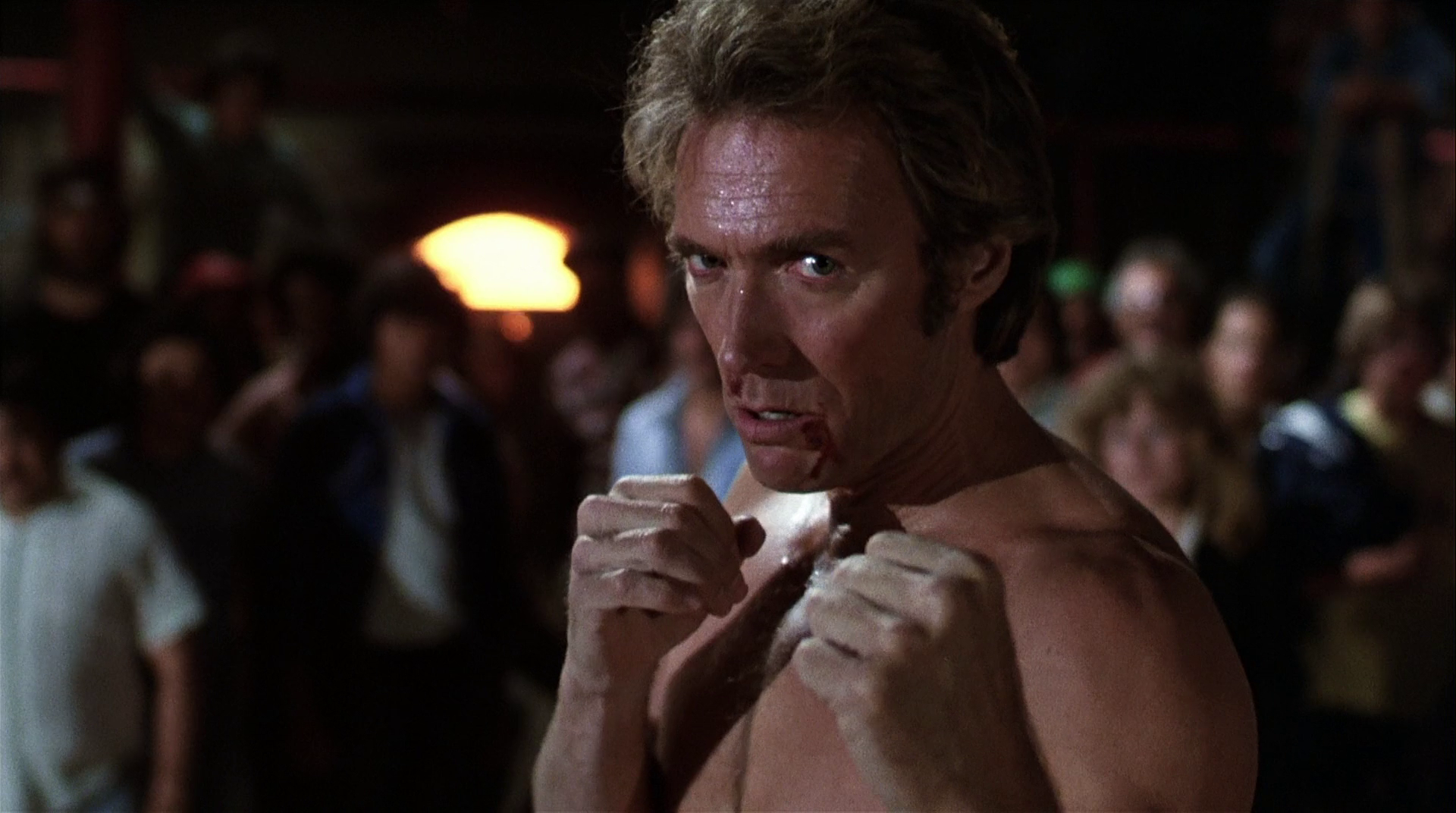
Eastwood plays Philo Beddoe a good natured but tough bare knuckle fighter who falls for a country and western singer played by Sondra Locke (Eastwood’s lover at the time). As well as his growing reputation on the underground fighting circuit (where he seems set for a showdown with the top fighter Tank Murdock) Eastwood runs afoul of two off duty cops in a bar room brawl and finds himself in a feud with a local biker gang the Black Widows after get into altercations with several of it’s members and keeping their bikes after beating them in fights.
When Locke disappears from town, Beddoe his best friend Orville and Clyde set off on a roadtrip to find her. Unbeknown to Beddoe she and her lover are actually con artists who travel from town to town tricking local guys to fall for her and invest in her music career. The two cops and Black Widows are also in pursuit looking to extract revenge, while Beddoe uses the trip as an opportunity to finally match up with Tank Murdock.

Everywhich Way But Lose and it’s sequel Anywhich Way you Can, were and still are absolutely derided by critics, yet were massive hits at the box office and were Eastwood’s most successful up to that point. I still have a lot of affection for them, especially the first one. The bare knuckle fights are good, as is the showdown with Beddoe and the Black Widows where he takes on around twenty of the gang single handed. The Widows themselves are funny as the bumbling bikers, with a wide range of characters and led by John Quade who was a semi regular in Eastwood movies.
One of the scene stealers is Ruth Gordon as the cranky old woman “Ma,” Orville’s mother and Beddoe’s landlady. She’s hilarious, screaming, ranting and swearing, especially when it comes to Clyde. However her greatest scene is when the Black Widows show up at her house and after they break some property so takes out a rifle and drives them off.
Even the much mocked Clyde is entertaining and his relationship with Eastwood is touching although it does feel a little creepy with how far the affection goes when Clint actually kisses the ape from time to time (although not as bad as when he shares a bed with the character in the sequel played by a different ape).
I still like this film today. It’s a light weight comedy but still fun, with enjoyable characters and some old school entertaining fisticuffs. Not something I’d recommend going out of your way to see, but if it crops up on television or a streaming service you subscribe to is an easy way to switch your mind off and spend a brisk couple of hours on.

WTF Moment presents……….The Swarm
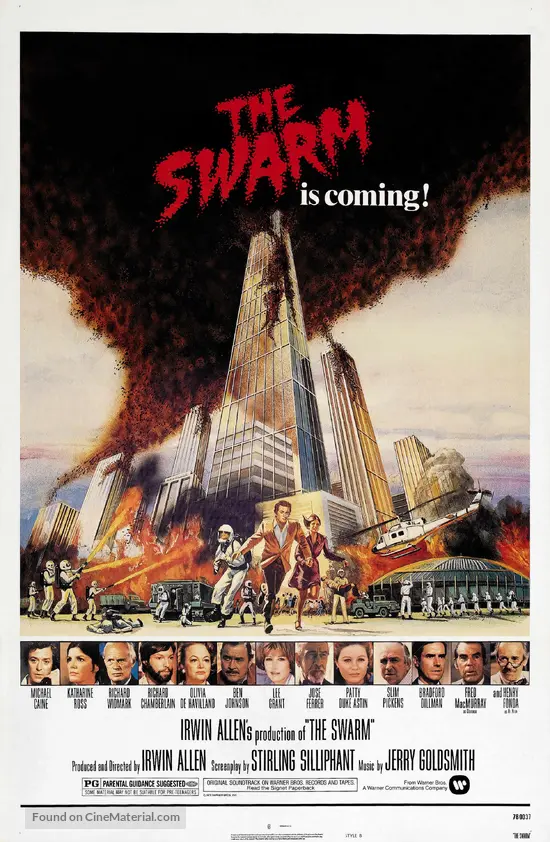
If you’re a regular reader of Couchzone movie club (and God bless you if you are) you may know that Michael Caine has shown up in my passion for movies many times. Hardly surprising as his charisma and touch of class has been added to some classic movies and iconic characters. He’s also be in some right drivel.
As exhibit A, I present The Swarm. A disaster movie that exploited a once prominent scare of deadly African Bees invading the US shores (insert your own political commentary here.)
In The Swarm, we first meet Caine at an army base where all the personal have been discovered dead, victims it transpires of a deadly swarm of bees that Caine a scientist has been tracking. Caine has been apparently planning for the day when insects would rise against man and is put in charge of mounting a defence by the President himself. Caine assembles his crack crew of specialists to combat the Bee menace, leading to one of the most unintentionally hilarious lines in the film.
” We’ve been fighting a losing battle against the insects for fifteen years, but I never thought I’d see the final face-off in my lifetime. And I never dreamed, that it would turn out to be the bees. They’ve always been our friend.”

These murderous, fucking Bees descend on a wholesome small town where they kill two parents while having a picnic as their son watches horrified from the inside of a car. Next target is the centre of town and later the local school which sees a surprising number of kids dead on the playground covered with the nasty little winged fuckers. (You’ve always been our friends you bastards!) Naturally it been a disaster movie there’s a little bit of backstory as the headmistress is caught in a love triangle with two suitors. We never find out which one she chooses (to the disappointment of the two people that got invested in the subplot) as all three are killed when the bees take out the train they were evacuating town on. Yes the Bees cause a train to crash.
The bees also manage to take out a nuclear power plant. After this the President realises this crack team of experts assembled ain’t doing shit and hands the whole thing over to the military. Their genius response is to attack the bees who have spread to the city of Houston with flame throwers, which as well as killing some bees destroys any buildings they were swarming around. Fucking brilliant, but what’s Houston ever done for us anyway?
Long story short the bees attack and destroy the military HQ however Caine realises the bees are attracted by alarms and bells (like at the base and the school) and so uses loudspeakers to draw the bees out into the ocean and destroy the whole swarm with missiles.
The Swarm is gunk and appears regularly on the worst movies of all time lists. Bad as it is this may be it’s slightly over the top, as I’ve seen far worse films than anything that appears on these lists. That said, it’s still unforgivably stupid but is entertaining because of it especially with a cast along side Caine that includes Richard Chamberlain, Katherine Ross and Richard Widmark.
The film was directed by Irwin Allen who followed this up by making a sequel to the Poseidon Adventure (one of my favourites) called “Beyond the Poseidon Adventure.” Incredibly Caine returned to work with Allen on this one who proved what a pussy Gene Hackman was by going into the depths of the ship and out again while having gun battles with Telly Savalis.
The film ends with this disclaimer.
‘The African killer bee portrayed in this film bears absolutely no relationship to the industrious, hardworking American honey bee to which we are indebted for pollinating vital crops that feed our nation.’
Next time I’ll be of course talking about 1979, and oh man have I got a little known cult doozy for you all. I really can’t wait.
Dazza


